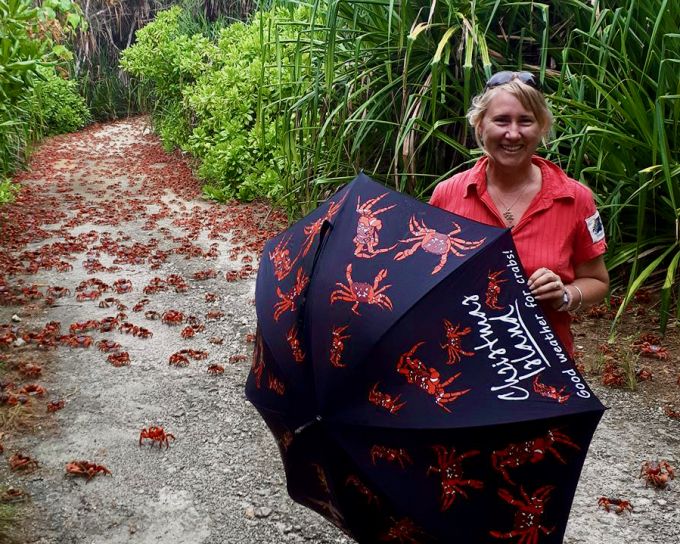Fish & Marine Invertebrates
Australia has the most biodiverse waters on the planet.
With a coastline that stretches over 37,000 kilometres (23,000 miles), Australia lines three of the world’s largest oceans. Consequently, the country’s waters are diverse, ranging from tropical seas, through to temperate and sub-Antarctic waters.
Perhaps, there is no greater association with Australia’s marine offering than its coral reefs. Venturing to Australia's west coast, the world's largest extensive fringing reef is found in the Ningaloo Marine Park, home to the graceful Whale Shark, the world's largest migration of Humpback Whales and 50 per cent of Indian Ocean's coral species.The Great Barrier Reef is the largest living structure on earth and one of the most complex ecosystems. Stretching 2,300 kilometres off the continent's northeast, the Great Barrier Reef Marine Park is roughly the same area as Japan, Germany, Malaysia or Italy.
But it is the richness of Australia’s temperate marine environments that is surprising. By far the greatest proportion of biodiversity is found along the southern Australian coastline where 85% of fish, 90% of echinoderms (starfish, sea urchins, sea cucumbers) and 95% of molluscs are considered endemic with new species being discovered everyday.
Australia’s oceans support over 5,000 species of fish, more than half of the shark and ray species in the world, six of the seven known species of marine turtles, tens of thousands of species of invertebrates, over half of the world’s 58 seagrass species, and countless micro-organisms. Life beneath the surface in Australia is simply extraordinary.
Search for tours including Fish & Marine Invertebrates, using the seasonal viewing opportunities calendar further down the page or by using the map button directly below:
Viewing opportunities that include fish & marine invertebrates
-
January,February,December, Christmas Island
Christmas Island - Summer Sightings for Fish & Marine Invertebrates
Fish Angelfish: Yellowhead Angelfish, Cocopeel Angelfish, Regal Angelfish, Emporer Angelfish, Threespot Angelfish, Semicircle Angelfish, Bicolor Angelfish | Batfish: Round Batfish, Longfin Batfish | Butterflyfish: Raccoon Butterflyfish, Ornate Butterflyfish Spotted Butterflyfish, Meyer's Butterflyfish, Forceps Butterflyfish, Threadfin Butterflyfish, Teardrop Butterflyfish, Longnose Butterflyfish, Chevron Butterflyfish, Pyramid Butterflyfish, Indian Redfin Butterflyfish | Anemonefish: Clark's Anemonefish, Pink Skunk Anemonefish, Orange Skunk Anemonefish | Damselfish: Golden Damselfish, Three-spot Dascyllus, Blackbar Damselfish, Jewel Damsel, Reticulated Damselfish, Blue-eye Damsel | Flutemouth: Pacific Trumpetfish, Bluespotted Cornetfish | Fusilier: Blue and Yellow Fusilier, Neon Fusilier, Wide-band Fusilier | Moray Eels: Masked Moray, Whitemouth Moray, Ribbon Eel, Yellowmargin Moray, Giant Moray Eel | Parrotfish: Redlip Parrotfish, Bluepatch Parrotfish, Sixband Parrotfish, Swarthy Parrotfish, Indian Bullethead Parrotfish | RockCod: Coral Grouper, Peackock Grouper, Masked Grouper, Flagtail Grouper, Foursaddle Grouper, Leopard Rockcod | Scorpionfish: Leaf Scorpionfish, Zebra Lionfish, Spotfin Lionfish, Tassled Scorpionfish | Surgeonfish: Whitecheek Surgeonfish, Orangeblotch Surgeonfish, Striped Surgeonfish, Pacific Orange-spine Unicornfish, Convict Surgeonfish, Powder Blue Tang, Spotted-face Surgeonfish, Palette Tang, Paletail Unicornfish | Triggerfish: Black Triggerfish, Pinktail Triggerfish, Flagtail Triggerfish, Orangestripe Triggerfish, Titan Triggerfish, Lei Triggerfish, Glided Triggerfish | Wrasses: Checkerboard Wrasse, Yellowtail Coris, Rockmover Wrasse, Barred Thicklip, Claudia's Wrasse, Earmuff Wrass, Chiseltooth Wrasse, Redshoulder Wrasse, Indo-Pacific Wrasse, Bluestreak Cleaner Wrasse, Ringtail Maori Wrasse, Bird Wrasse, Sunset Wrasse
Sharks & Rays Sharks: Whale Shark, Whitetip Reef Shark, Silky Shark, Blacktip Reef Shark, Grey Reef Shark | Rays: Blotched Fantail Ray, Bentfin Devil Ray, Whitespotted Eagle Ray, Manta Ray
Molluscs Nudibranch: Domino Nudibranch, Indian Caloria, Carmel Nudibranch | Shrimp: Marbled Shrimp, Banded Coral Shrimp, Squat Anemone Shrimp | Clam: Electric Fileclam, Small Giant Clam, Noah's Giant Clam
Corals & Sea Anemones Hard Corals (Scleractinia): Staghorn, Brain, Elkhorn, Table, Closed Brain, Honeycomb, Lobed Star, Bubble, Finger, Porite | Soft Corals (Alcyonacea): Tree, Cabbage Leather, Weeping Willow, Sea Whips, Sea Plumes, Sea Rods, Organ Pipe Coral, Pink Nephthya, Blue Soft Coral, Gorgonian Sea Fan, Elephant Ear, Cauliflower, Sea Pen | Sea Anemones: Adhesive Anemone, Elephant Ear Anemone, Magnificent Sea Anemone, Merten's Sea Anemone, Ghost Tube Anemone
Crabs Red, Purple Blue & Brown Crabs: Christmas Island Red Crab, Purple Crab, Blue Crab, Brown Crab | Robber & Hermit Crabs: Giant Robber Crab, Red Hermit Crab, Purple Hermit Crab, Tawny Hermit Crab | Ghost Crabs: Horn-eyed Ghost Crab, Smooth-handed Ghost Crab | Nippers and other Grapsids: Little Nipper, Red Nipper, Yellow Nipper, Yellow-eyed Crab, White-stripe Crab, Jackson's Crab, Mottled Crab, Grapsus Crab, Sandy Rubble Crab, Freshwater Crab
How to find experience the Red Crab Migration

At the onset of Christmas Island's wet season (which can be early as mid November), the crabs are triggered to abandon their burrows on the top plateau and head down to the lower terraces for mating. Generally the males set off first, with the females following a few days or a week later.This part of the migration is very unpredictable and dependent on the start and continuity of the seasonal rain. The next stage, the Red Crab spawning, is more predictable, as the female crabs need to drop their eggs into the sea using very specific tides, which can be predicted. There are generally two consecutive mornings in November and/or December. The dates change each year and where these tides fall in the month determines the greater likelihood of there being either a November or December spawning, or possibly both months. The Red Crabs start dropping their eggs around 4am, and stop as the sun rises. Once they have delivered their spawn to the sea, they then head back up to the forest. Spawning tours can only be operated on the mornings of those specific dates. A shorter stay on the island is possible, depending on the flight options.
Suggested Tour: Christmas Island Ultimate Wildlife
Duration: 8 days/7 nights
Type: PrivateChristmas Island's geographic isolation and minimal human disturbance has produced an incredible level of biodiversity and endemism, leading to the label of the 'Galapagos of the Indian Ocean'.
Tours in Christmas Island related to Fish & Marine Invertebrates





